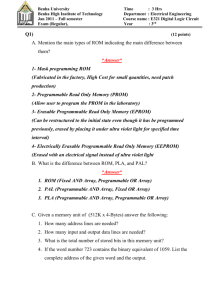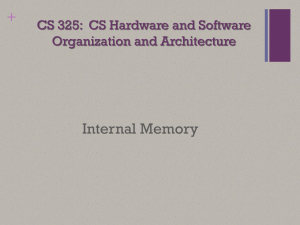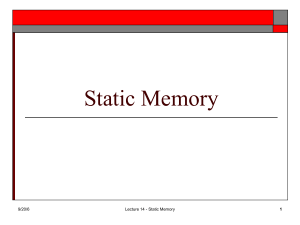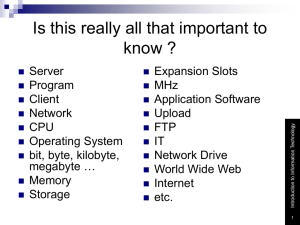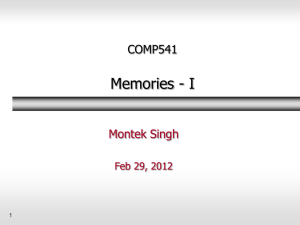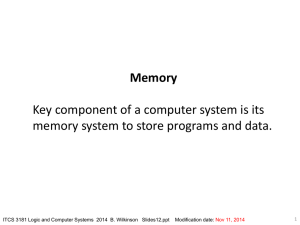CS1104: Computer Organisation
advertisement
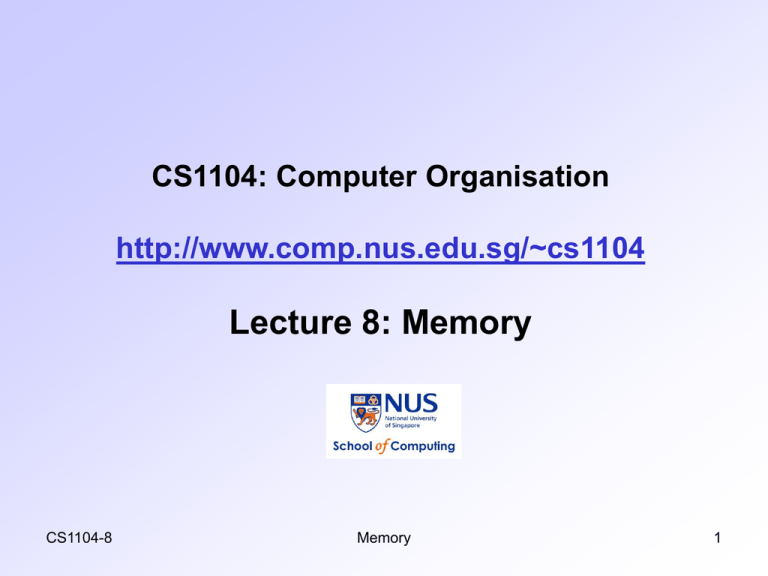
CS1104: Computer Organisation http://www.comp.nus.edu.sg/~cs1104 Lecture 8: Memory CS1104-8 Memory 1 Lecture 8 Memory Basics Memory Hierarchy Data Transfer Memory Unit Read/Write Operations Memory Cell Memory Array CS1104-8 Memory 2 Basics Memory stores programs and data. Definitions: 1 byte = 8 bits 1 word: in multiple of bytes; a unit of transfer between main memory and registers, usually size of register. 1 KB (kilo-bytes) = 210 bytes; 1 MB (mega-bytes) = 220 bytes; 1 GB (giga-bytes) = 230 bytes; 1TB (tera-bytes) = 240 bytes. Desirable properties: fast access, large capacity, economical cost, non-volatile. However, most memory devices do not possess all these properties. CS1104-8 Memory 3 Memory Hierarchy Fast, expensive (small numbers), volatile registers main memory disk storage Slow, cheap (large numbers), non-volatile magnetic tapes CS1104-8 Memory 4 Data Transfer (1/2) Processor Up to 2k addressable locations. Address k-bit address bus MAR Memory 0 1 2 3 4 5 n-bit data bus MDR : Control lines (R/W, etc.) CS1104-8 Memory 5 Data Transfer (2/2) A memory unit stores binary information in groups of bits called words. The data consists of n lines (for n-bit words). Data input lines provide the information to be stored (written) into the memory, while data output lines carry the information out (read) from the memory. The address consists of k lines which specify which word (among the 2k words available) to be selected for reading or writing. The control lines Read and Write (usually combined into a single control line Read/Write) specifies the direction of transfer of the data. CS1104-8 Memory 6 Memory Unit Block diagram of a memory unit: n data input lines n k address lines k Memory unit 2k words n bits per word Read/Write n n data output lines CS1104-8 Memory 7 Read/Write Operations (1/2) The Write operation: Transfers the address of the desired word to the address lines. Transfers the data bits (the word) to be stored in memory to the data input lines. Activates the Write control line (set Read/Write to 0). The Read operation: Transfers the address of the desired word to the address lines. Activates the Read control line (set Read/Write to 1). CS1104-8 Memory 8 Read/Write Operations (2/2) The Read/Write operation: Memory Enable Read/Write Memory Operation 0 X None 1 0 Write to selected word 1 1 Read from selected word Two types of RAM: Static and dynamic. Static RAMs use flip-flops as the memory cells. Dynamic RAMs use capacitor charges to represent data. Though simpler in circuitry, they have to be constantly refreshed. CS1104-8 Memory 9 Memory Cell A single memory cell of the static RAM has the following logic and block diagrams: Select Select R Input S Q Output BC Output Read/Write Read/Write Logic diagram CS1104-8 Input Block diagram Memory 10 Memory Array (1/4) Logic construction of a 4 x 3 RAM (with decoder and OR gates): CS1104-8 Memory 11 Memory Array (2/4) An array of RAM chips: memory chips are combined to form larger memory. A 1K x 8-bit RAM chip: RAM 1K x 8 Input data 8 Address 10 Chip select Read/write DATA (8) ADRS (10) CS RW (8) 8 Output data Block diagram of a 1K x 8 RAM chip CS1104-8 Memory 12 Memory Array (3/4) Address Lines 11 10 Input data Lines 0–9 8 lines DATA (8) (8) ADRS (10) CS 1K x 8 RW 2x4 decoder S0 S1 0 1 2 3 1024 – 2047 DATA (8) (8) ADRS (10) CS 1K x 8 RW 2048 – 3071 Read/write DATA (8) (8) ADRS (10) CS 1K x 8 RW 3072 – 4095 4K x 8 RAM. CS1104-8 0–1023 DATA (8) (8) ADRS (10) CS 1K x 8 RW Memory Output data 13 Memory Array (4/4) 21-bit addresses 19-bit internal chip address A0 A1 A19 A20 2-bit decoder 512K x 8 memory chip 8-bit data input/output 19-bit address Chip select CS1104-8 512k X 8 memory chip D31-24 D23-16 D 15-8 D7-0 Another example: Organization of a 2M 32 memory module using 512K 8 static memory chips. Memory 14 End of file CS1104-8 Memory 15


